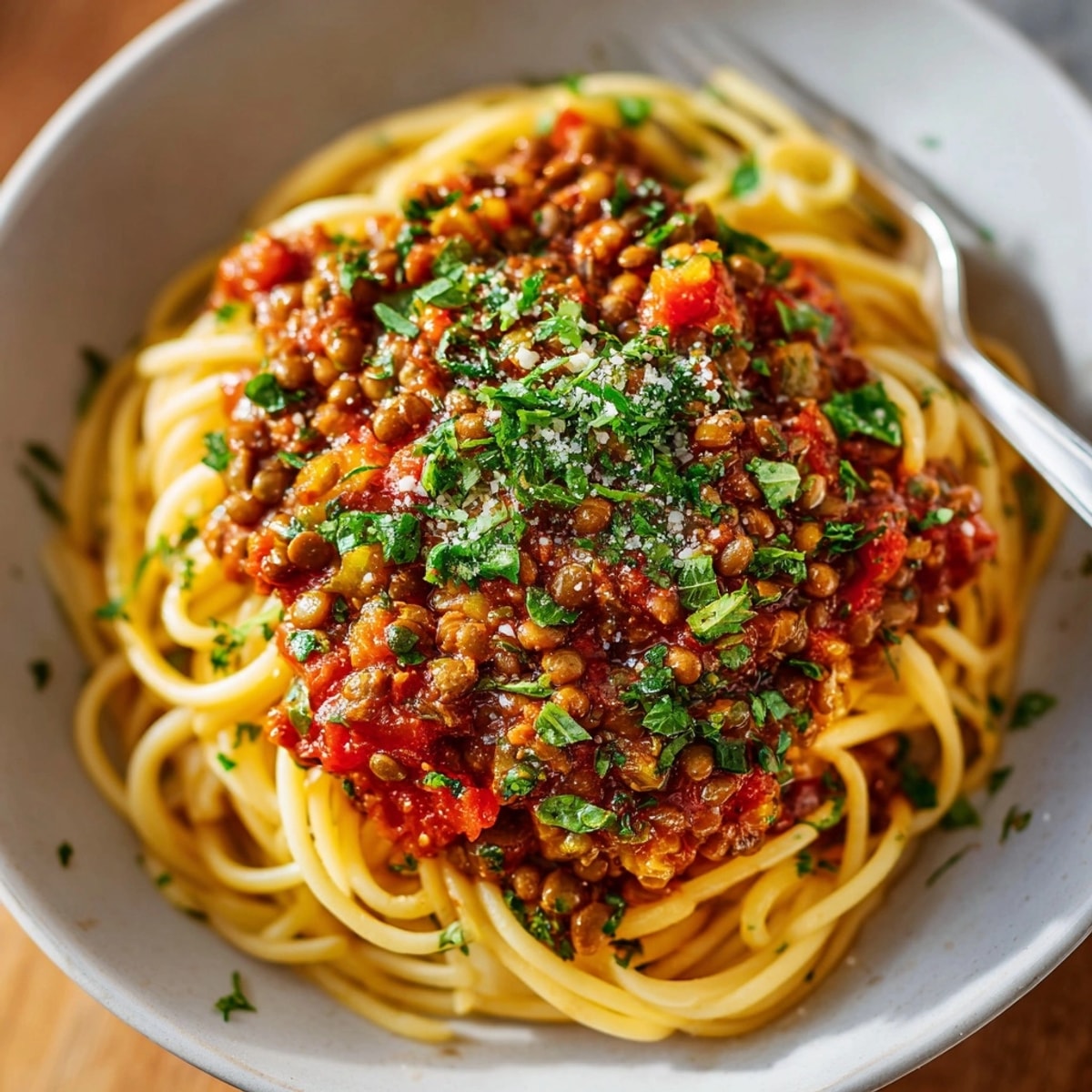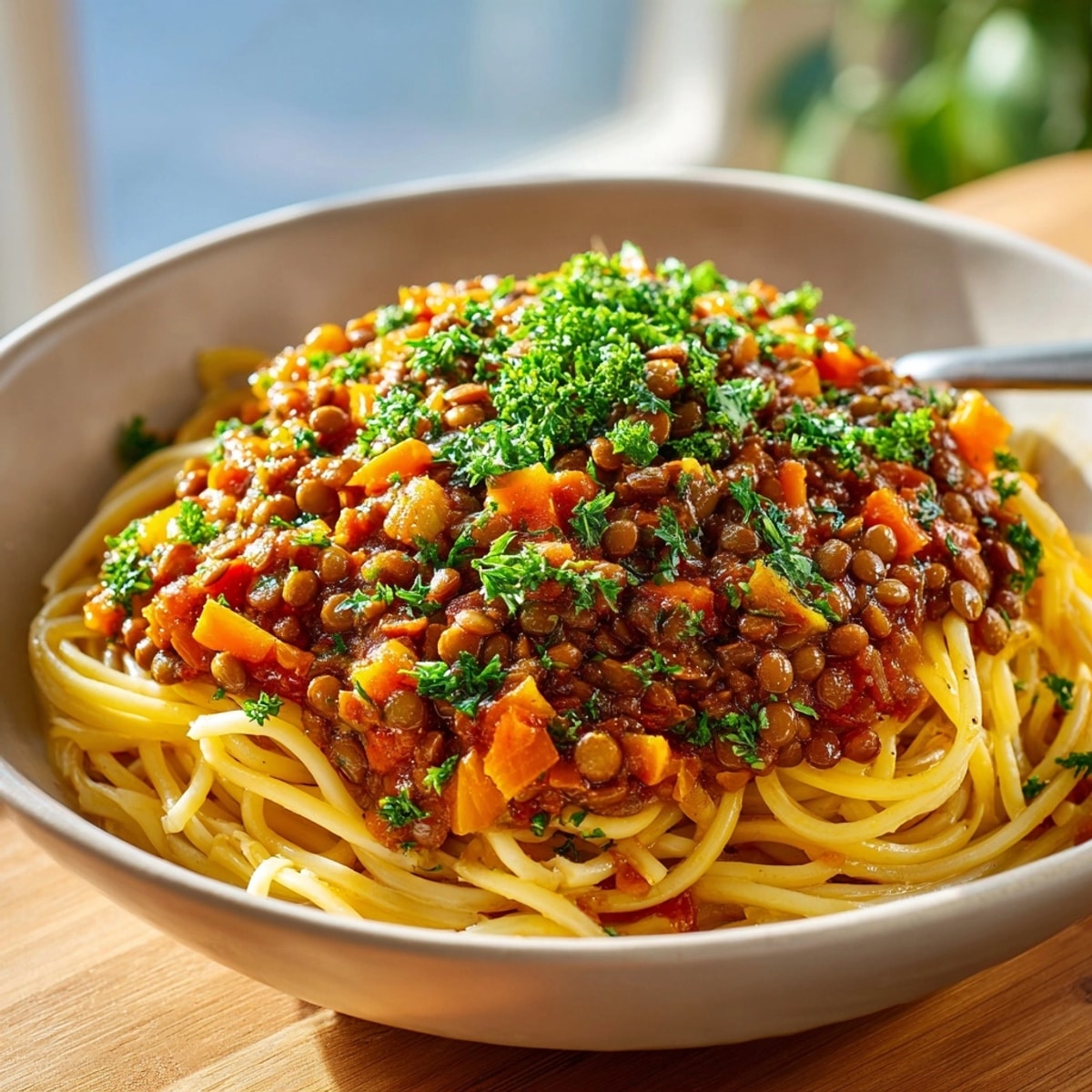 Save
Save This hearty lentil bolognese with walnut meat texture has transformed my weeknight dinner routine, offering all the satisfaction of traditional Bolognese without any meat. The combination of protein-rich lentils and walnuts creates an incredibly convincing texture that even my carnivore friends request repeatedly.
I first created this recipe during a cold winter weekend when I was craving comfort food but wanted something healthier. What started as an experiment has become our family's go-to Sunday dinner, with my partner always asking for seconds.
Ingredients
- Brown or green lentils: These provide the perfect hearty texture and absorb flavors beautifully. Choose lentils that look uniform in color without broken pieces.
- Walnuts: The secret to creating that meaty texture. Look for raw unsalted walnuts for the best flavor.
- Yellow onion: Forms the flavor foundation. Select firm onions without soft spots.
- Carrots and celery: The traditional Italian soffritto base that adds sweetness and depth. Choose bright orange carrots for best flavor.
- Garlic: Fresh cloves provide much better flavor than pre-minced versions.
- Crushed tomatoes: The main sauce base. San Marzano tomatoes offer superior flavor if available.
- Tomato paste: Concentrated flavor that adds richness. Look for paste in tubes for easier storage.
- Vegetable broth: Adds depth while keeping the sauce vegan. Homemade is best but quality store-bought works well.
- Soy sauce: Provides umami depth that mimics the savory quality of meat. Use tamari for gluten-free option.
- Balsamic vinegar: Adds subtle sweetness and acidity. Even a small amount makes a big difference.
- Dried herbs: The classic Italian blend that perfumes the entire sauce.
- Smoked paprika: Adds a subtle smokiness that enhances the meaty illusion.
Instructions
- Cook the lentils:
- Cover lentils with plenty of water in a medium saucepan. Bring to a boil then reduce to a simmer. Cook for about 15 to 20 minutes until the lentils are tender but still hold their shape. You want them slightly al dente as they will continue cooking in the sauce later. Drain thoroughly and set aside.
- Prepare the soffritto base:
- Heat olive oil in a large Dutch oven or heavy-bottomed skillet over medium heat. Add your diced onion, carrots, and celery. Cook this mixture slowly for a full 7 to 8 minutes, stirring occasionally. This slow cooking process caramelizes the vegetables slightly, building a crucial flavor foundation. The vegetables should become soft and the onions should turn translucent with golden edges.
- Develop the aromatics:
- Add the minced garlic to the softened vegetable mixture. Cook for exactly one minute, stirring constantly to prevent burning. You should smell the garlic becoming fragrant but not taking on any color. This brief cooking time prevents bitterness while releasing essential flavors.
- Build the flavor base:
- Add tomato paste and cook for one minute, stirring constantly to slightly caramelize it, which adds richness and umami. Then add the processed walnuts and toast for two minutes, stirring frequently. The walnuts will become fragrant as their natural oils release, adding both texture and a subtle nutty flavor that enhances the meaty quality.
- Combine and simmer:
- Add the cooked lentils, crushed tomatoes, vegetable broth, soy sauce, balsamic vinegar, and all dried herbs and spices. Stir thoroughly to incorporate all ingredients. Bring the mixture to a gentle simmer, then reduce heat to maintain a slow bubble. Cook uncovered for 20 to 25 minutes, stirring occasionally to prevent sticking. The sauce will gradually thicken as excess liquid evaporates, concentrating the flavors.
- Season and adjust consistency:
- Taste the sauce and add salt and freshly ground black pepper as needed. Remember that soy sauce already adds saltiness, so start conservatively. If the sauce becomes too thick during cooking, add small splashes of broth or water until you reach your desired consistency. The final texture should coat pasta beautifully without being watery.
- Serve with love:
- Ladle the hot sauce generously over your favorite cooked pasta. Garnish with freshly chopped basil or parsley just before serving to add color and a burst of fresh flavor. The contrast between the rich sauce and bright herbs creates a perfect balance.
 Save
Save The walnuts are truly the magic ingredient in this recipe. I discovered their transformative power accidentally when I ran short on lentils one day and supplemented with ground walnuts. The resulting texture was so remarkably similar to traditional meat Bolognese that it became a permanent addition. Their natural oils also add richness that makes this sauce incredibly satisfying.
Make-Ahead and Storage Tips
This lentil bolognese actually improves with time as the flavors continue to develop. You can prepare it up to three days ahead and store in an airtight container in the refrigerator. When reheating, add a splash of water or broth if the sauce has thickened too much. For longer storage, portion the cooled sauce into freezer-safe containers, leaving about an inch of headspace for expansion. It freezes beautifully for up to three months. Thaw overnight in the refrigerator before reheating gently on the stovetop.
Clever Substitutions
The beauty of this recipe lies in its flexibility. If you have a nut allergy, replace walnuts with sunflower seeds or pumpkin seeds for a similar texture. Red lentils can substitute for brown or green, but reduce cooking time to about 10 minutes as they break down more quickly. For extra umami depth, try coconut aminos instead of soy sauce, which also makes the recipe soy-free. In a pinch, balsamic glaze can replace both balsamic vinegar and some of the sweetness. During tomato season, use 6 cups of fresh diced tomatoes instead of canned for an even more vibrant flavor.
Serving Suggestions
While traditional spaghetti is a classic pairing, this robust sauce works wonderfully with heartier pasta shapes that catch the chunky texture. Try it with rigatoni, pappardelle, or whole grain penne. For a lower-carb option, serve over roasted spaghetti squash or zucchini noodles. The sauce also makes an incredible filling for stuffed bell peppers or a hearty layer in vegetable lasagna. For a complete meal, serve alongside a peppery arugula salad dressed simply with lemon juice and olive oil to cut through the richness of the sauce.
The History Behind the Dish
Traditional Bolognese sauce originates from Bologna, Italy, where it's known as ragù alla bolognese. The authentic version typically includes meat, soffritto (onion, celery, carrot), white wine, milk, and tomatoes, simmered slowly for hours. This plant-based adaptation honors the technique and flavor profile while making it accessible to those following plant-based diets. The addition of lentils is particularly fitting as they have been a staple in Italian cuisine for centuries, especially in regions like Umbria where lentil soups and stews are traditional comfort foods.
 Save
Save I learned through many iterations that the key to this recipe's success is patience. Allowing the soffritto to properly caramelize and giving the sauce ample time to simmer makes all the difference between a good Bolognese and an exceptional one. Trust the process, and you'll be rewarded with a sauce that rivals its meat-based inspiration.